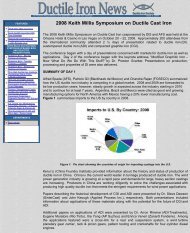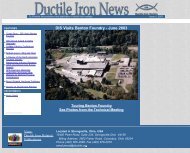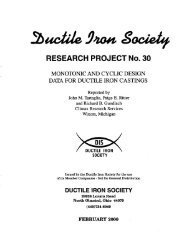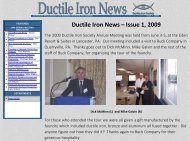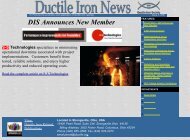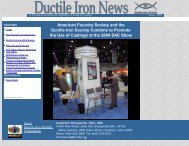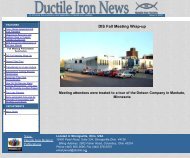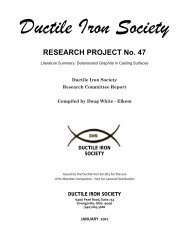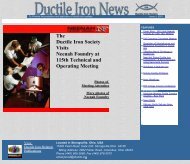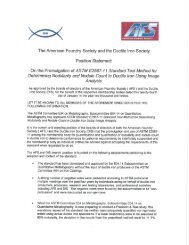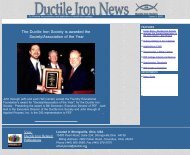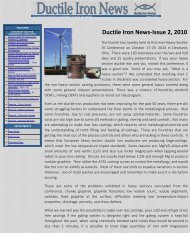You also want an ePaper? Increase the reach of your titles
YUMPU automatically turns print PDFs into web optimized ePapers that Google loves.
esults. The program only advised on using either carbon or FeSi75 for making the trim additions, not both. I designed my Excel program to<br />
recommend adding both materials at once if needed, as shown under Furnace 1 in Figure 6. The second problem was that I had to wait over three<br />
minutes for the curve to complete before I could view the “active carbon” and also review ATAS’s recommendations. As I mentioned before, this<br />
could potentially slow production down.<br />
Figure 6 Excel cheat sheet used by our furnace operators.<br />
ACTIVE CARBON<br />
As a review and reminder;<br />
By knowing the bath’s equilibrium temperature, I changed our sampling procedure so that on a new<br />
furnace, the furnace operators would pour an ATAS grey cup and allow the curve to go to<br />
completion. Allowing the curve to go to completion is done solely to obtain the “active carbon”<br />
reading. The ACEL reading is still viewed at the liquidus temperature, roughly 30 seconds into the<br />
curve. The furnace operators would then input the recorded ACEL and carbon reading into the<br />
Excel mass balance program and make any recommended trim additions. Once the furnace<br />
operators know the ACEL and “active carbon” (C) reading, and the fact that we hold our pouring<br />
temperature above the equilibrium temperature, all they need to do for the remainder of the<br />
furnace is to pour a cup and obtain the ACEL (which takes 30 seconds not 3 minutes to view). Any<br />
variation between the newly poured ACEL and the previously poured ACEL is relative to the<br />
furnace carbon activity, which is based on the furnace temperature versus equilibrium temperature,<br />
in theory. Example, if the furnace temperature is above the calculated equilibrium temperature and<br />
the ACEL dropped by three points, only carbon would be used to trim the furnace.<br />
Total Carbon =Active Carbon + Inactive Carbon. Carbon analyzed with a spectrometer or Leco shows ALL carbon in a sample. However it does not<br />
tell us in which form the carbon is present. It can be as carbon dissolved in the ferrite, as iron carbide, as other carbides, as graphite precipitated<br />
from carbon dissolved in the liquid during solidification, and as graphite particles that were not dissolved but suspended in the liquid. For the<br />
metallurgist the interesting part is of course to know how much carbon there is that can result in graphite precipitation, known as “active carbon”.<br />
Active Carbon =dissolved carbon that has crystallized as graphite. Due to evolved latent heat it will influence the cooling curve from TeLow to TS;<br />
therefore it is measured by calculating the area under the curve from TeLow to TS. See figure Figure 7<br />
Inactive Carbon =what is tied up as primary carbides, and /or micro particles of graphite that has not been dissolved.<br />
Figure 7 Example of cooling curve which shows area between TeLow and TS.<br />
During ATAS installation NovaCast recommends using the carbon correction function (see Figure 8)<br />
to offset the carbon differences found between ATAS and Leco carbon combustion, or to use a<br />
tellurium thermal analysis system that predicts total carbon. The problem I see is how can we be<br />
confident that the “active carbon” from ATAS equals the “total carbon” measured by other means?<br />
To look into this further we have to mention what factors can alter “active carbon” metallurgically.<br />
Figure 8 ATAS screen showing carbon correction function.<br />
“Active carbon” can be influenced metallurgically by the amount of oxygen in the melt. The oxygen level in<br />
the bath is erratic and hard to control. High oxygen content reduces the ACEL (higher liquidus temperature)<br />
which makes the iron solidify as is the carbon content were lower than revealed by chemical analysis (“total<br />
carbon”). Factors that increase the oxygen content in iron include high amounts of steel scrap (worse if<br />
rusty), open furnace lid while melting and pouring (oxidizing atmosphere), and holding above the equilibrium<br />
temperature for a long time. Factors that decrease the oxygen content in the iron are addition of deoxidants<br />
such as FeSi, SiC, aluminum, or magnesium. Theoretically a small amount of deoxidant could be added to<br />
the pouring cup or spoon in order to drive out as much oxygen in the iron as possible when trying to<br />
compare ATAS “active carbon” results with Leco “total carbon” results (assuming there is no graphite in the<br />
Leco iron sample).<br />
Another variable that can alter the amount of “active carbon” precipitation is the solidification rate of the iron<br />
poured as shown in Figure 9. This figure is the top portion of Figure 4 where the curve on the right had an<br />
insulated ceramic fiber blanket (see Figure 3) wrapped around the cup which slowed the solidification rate.<br />
Here you can see the “active carbon” on the right is higher because more time was allowed for graphite<br />
precipitation. Another way of altering the solidification is through different pouring temperatures. It is highly recommended to pour the cups at the<br />
same temperature all the time. The red arrows in Figure 9 point to the top of the curve that represents 2462 °F. Pouring temperatures above this<br />
may break the quartz tubes and result in failed curves.<br />
Figure 9 Top portion of Figure 4. Curve on left represents normal cooling curve, while curve on right was from a cup that was insulated to<br />
alter the cooling rate.



